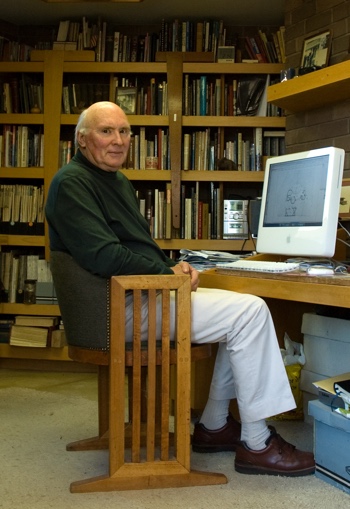Laurie Virr

Laurie Virr
Laurie Virr is a Canberra-based architect who has designed work in the United States, New South Wales and Victoria, along with a number of houses in Canberra. Throughout a career spanning over fifty years, his primary concerns have been the design of energy efficient, solar houses on rural sites and efficient planning for small spaces. Together with Enrico Taglietti, he has been one of the most original and important practitioners of the late twentieth century organic style of architecture working in Canberra.
Early years
Laurie Virr has qualifications in both architecture and engineering. From 1950 to 1958 he gained formal qualifications in civil engineering in England and was employed on large scale projects including bridges, water storage reservoirs, major storm water drainage works, high rise buildings and turbine installations. In Canberra, he played a role in the development of engineering infrastructure for the Russell Hill Defence complex.
From 1962 to 1966 Laurie Virr studied Architecture, graduating from the University of Melbourne with Honors in Design. This time included a period (1963-64) in the studio of American architect Malcolm Wells, in Cherry Hill, New Jersey. It was during this period that he designed and supervised the construction of his first passive solar house, and began to experiment with the idea of earth sheltered buildings. Examples of his work formed part of the Australian exhibits at The Commonwealth Institute, London, U.K. in 1972, and the Paris Biennale in 1982.
Work in Canberra
In January 1967 he established his own practice in Canberra, where he has remained since. His practice has been based on commissions for custom residences, with occasional forays into the design of workshops for light industrial processes. The majority of the residences have been at rural sites, and all of them have been either solar houses in cool temperate climates, or of low mass, as is required in tropical locations. Spasmodically, he has also been involved in the planning and design of a scheme for the establishment of solar precincts in areas of cities and towns subject to urban renewal. This work has attracted the attention of local authorities in New South Wales, and of a private developer in Massachusetts, U.S.A.
Laurie Virr’s first house in Canberra was built in the new bush suburb of Aranda in 1969 for Mr and Mrs Andrews. It demonstrates the themes he would explore in his residential projects over the next three decades: the use of massing, geometric forms and deep roof overhangs in an energy efficient, solar house.
The house, at Kambah, ACT, in which he lives, and which was constructed substantially with his own hands, has been widely published. It has achieved a minimum night temperature in winter of 12° Celsius without artificial heating, when the minimum temperature outdoors was -9° Celsius.
The house is an outstanding example of the late twentieth century organic style with its massing, use of geometric forms, deep roof overhang and energy efficient design. The successful implementation of a complex geometric plan based on a hemicycle is unusual if not unique for a mid-century Canberra house. The house has been published many times, in the United States, Europe and Australia. Inexplicably, it is relatively unknown in Canberra.
Teaching
Throughout his career Laurie Virr has been invited to conduct classes in Architectural Design and the Theory of Architecture, at a number of universities. Recently he was nominated for the Bruce Goff Chair of Creative Architecture at the University of Oklahoma, Norman, Oklahoma. He has been a guest lecturer at universities in Australia, including the University of Canberra, and the United States of America. These latter include the:
- Frank Lloyd Wright School of Architecture, Spring Green, Wisconsin
- College of Architecture, University of Oklahoma, Norman, Oklahoma
- University of Washington, Spokane
- University of Minnesota, Minneapolis
- University of Idaho, Moscow
Houses
- 5 Juad Place, Aranda (1969)
- House at Barragga Bay, New South Wales (1973)
- Rivendell, 17 Meredith Circuit, Kambah (1975)
- 14 Fergusson Crescent, Deakin (1982)
- House at Valla Beach, New South Wales (1998)
Source
- M. Parnell and G. Cole, Australian Solar Houses (1983)
- Conversations with and information provided by Laurie Virr